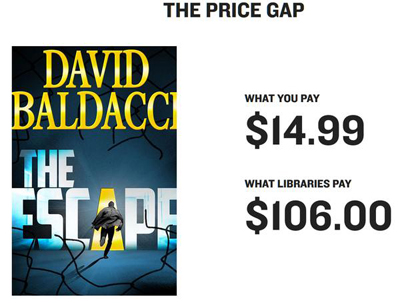
Go to Twitter. Type #FairEbookPrices. Any questions?
Our Canadian librarian colleagues are telling the world: Big publishers are ripping us off, big time.
If you’re one of the Big Five publishers, this is the conversation you do not want to have. You have a product—the ebook file representing a book—and you insist that it be treated like a book in some ways. Only one person can use it at a time. Patrons have to wait for it to become available. So in that respect, it’s not much better than print, even though, as every library patron knows, it makes as much sense to limit a file to one user at a time as it does to limit a web page to one exclusive viewer for three weeks at a time.
But the Big Guys also treat an ebook like it’s more valuable than a print book. Either the cost to libraries is six to eight times greater than the consumer cost, or the title magically disappears after some random number of uses, requiring library staff to evaluate its value, and order (or not order) it again, and perhaps to remove it from the catalog. So that’s a new staff cost, and a weird one. For libraries, it means that there’s no ownership at all, a whole new level of work, and no opportunity to resell a lackluster title at a cost that gives it a second chance with new readers. This represents a diminution of the market. And that hurts not just libraries and readers, but the creators of content.
What savings do libraries get from an ebook? Well, we don’t have to shelve it or mark it up. We don’t have to chase it down when it’s due. Are those savings worth six to eight times the cost? (Hint: no.)
Marketing guru Seth Godin says that the new book economy isn’t like the old. The issue isn’t scarcity, which we’ll define here as “trying to engineer ways to make it hard to find a title.” On the contrary, the problem of the 21st century book market is being noticed at all. In the digital world, the breakaway bestseller starts out free. People start to notice and talk about it. They download it, many at a time, just because of the buzz. They like it, so they buy it. The easier it is to find and investigate a book, the larger the sales. This has been demonstrated repeatedly.
If Godin is right, the Big Five desire for “friction,” for the greatest possible inconvenience to potential readers, is the surest possible strategy to (a) cut libraries out of the market altogether and/or (b) discourage library patrons (who are, by definition, big-time readers) from finding and buying digital content.
From my perspective, this is a really brilliant way for a big, legacy company (by legacy I mean old, slow, and doddering) to commit suicide, protecting its ownership of copyright while simultaneously ensuring that authors won’t see a penny. There may come a time when authors—the smart ones—jump ship.
But it’s also worth pointing out again that the Big Five command less and less of the total market. Midlist, small, independent, and self-publishers are surging into the library consciousness. It turns out that they offer (to those institutions that have the necessary infrastructure) both ownership and discounts. Libraries can buy more books, really good books, for less than the cost of print. We get to keep them, too.
The choice is simple: Buy less for more (the Big Five model), or buy more for less (the new publishers).
The emerging marketplace of publishing, and the best partner for libraries of all stripes, are those publishers who are in fact eager to work with us, who offer deals far better than those pushed by the current industry leaders.
Librarians: As our near-North colleagues are shouting from the Twittertops, the pricing models of the Big Five are antilibrary, antireader, and antiauthor. The pricing models of the new breed of publishers are friendly to library, reader, and author alike.
Think carefully: Who should we buy from?
